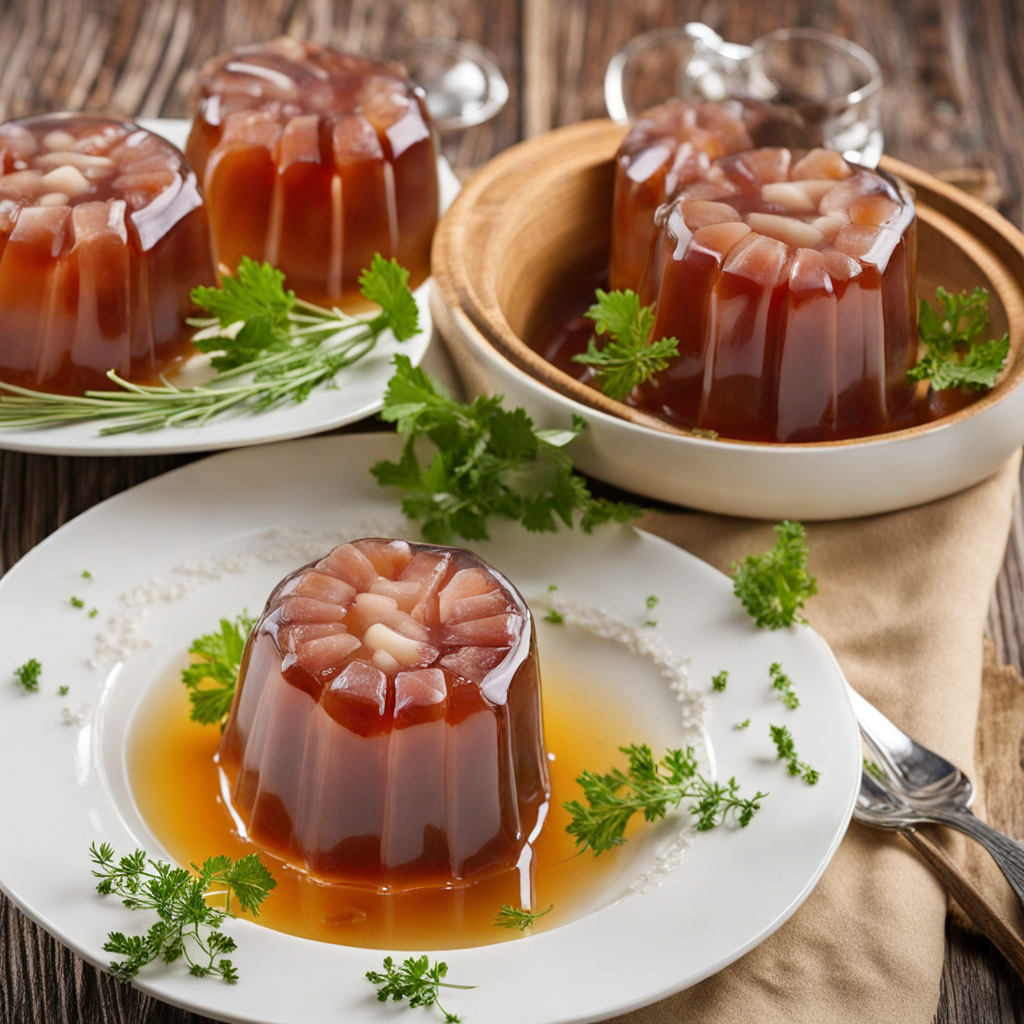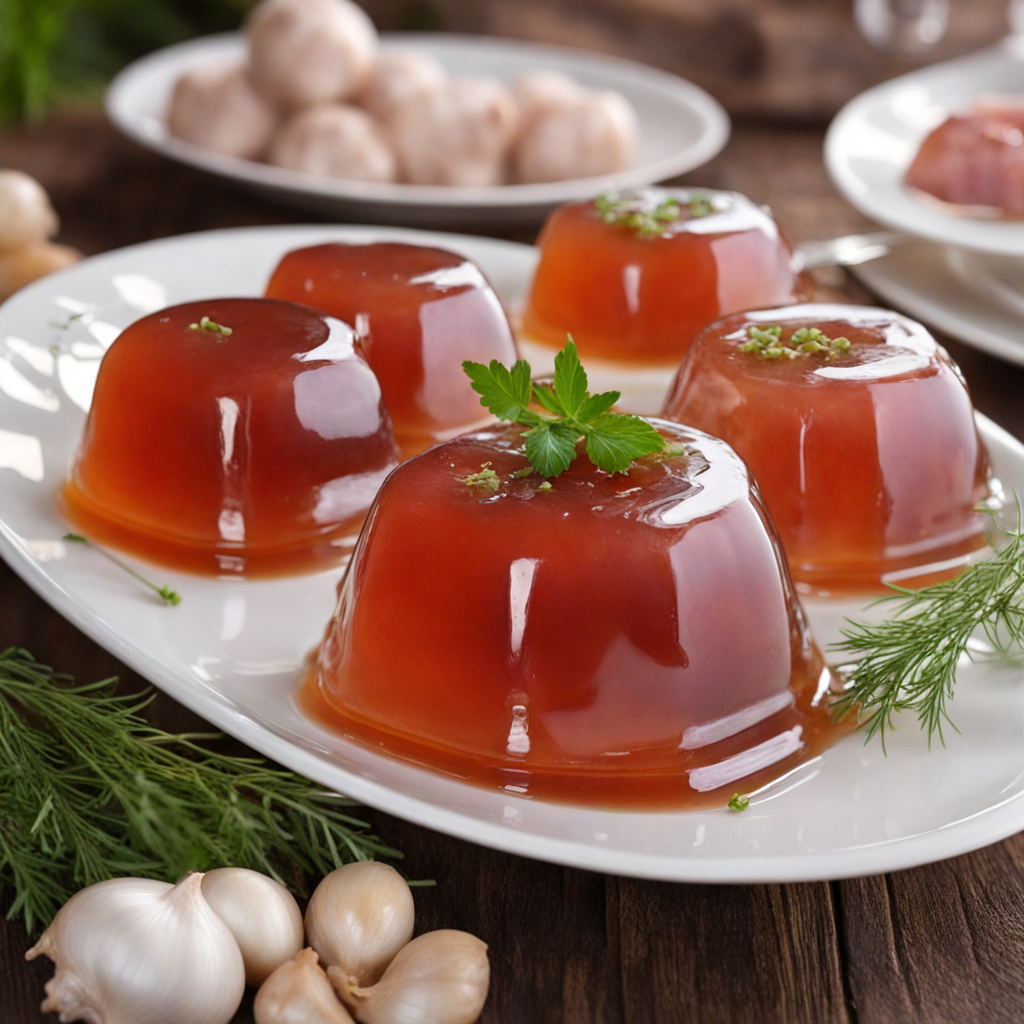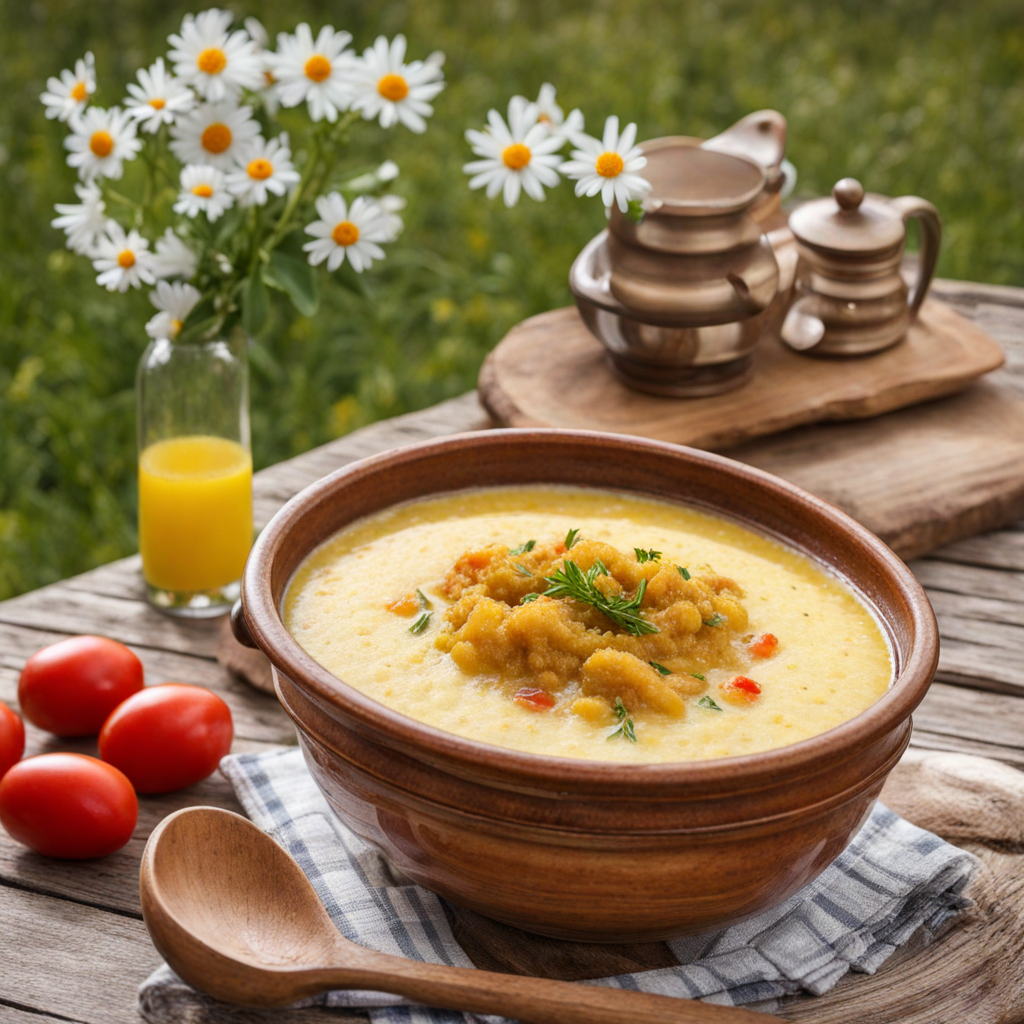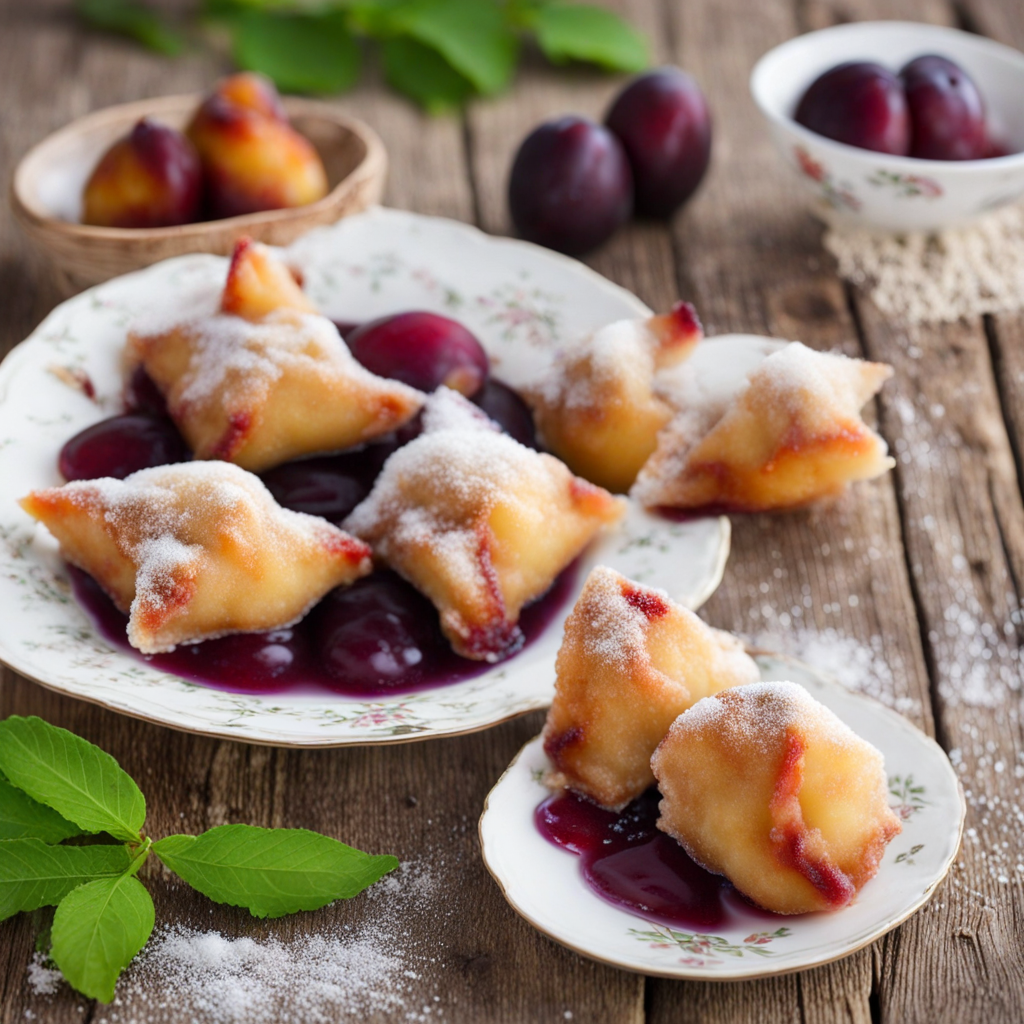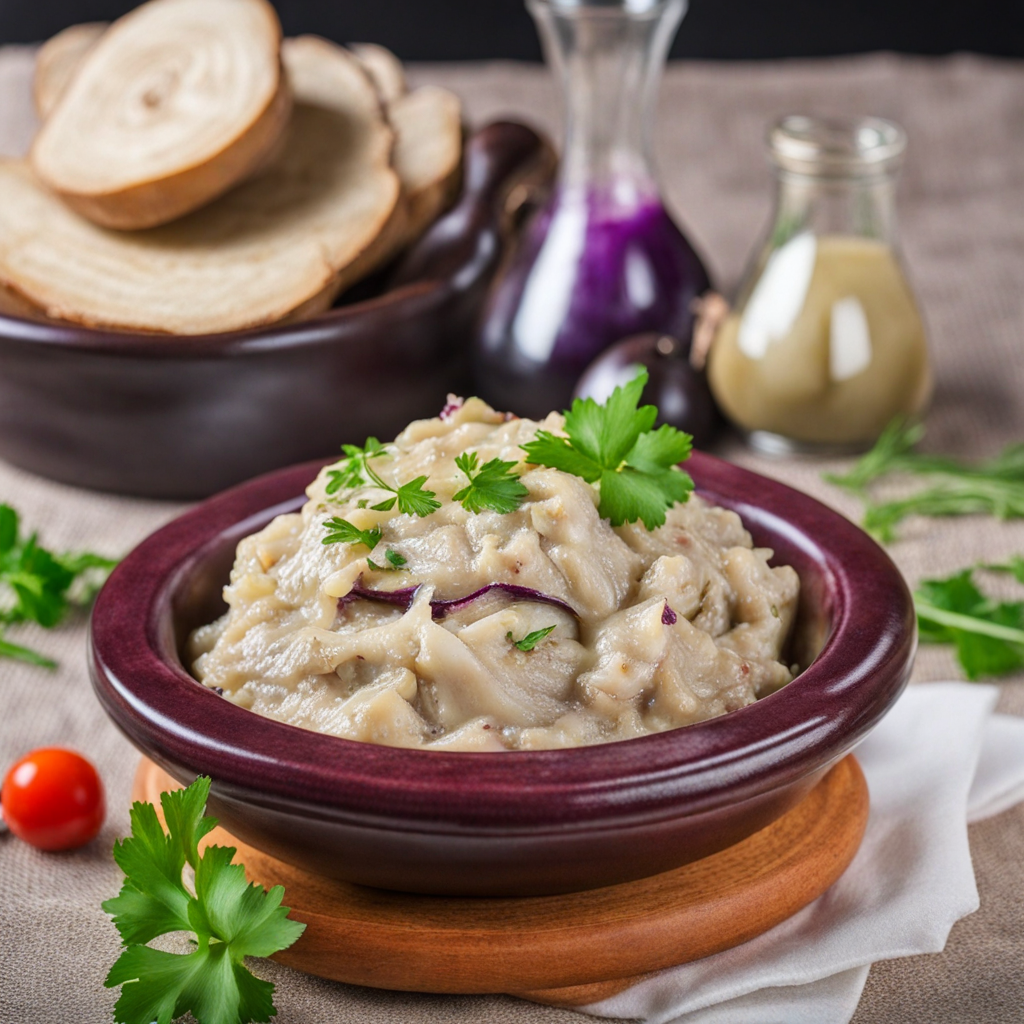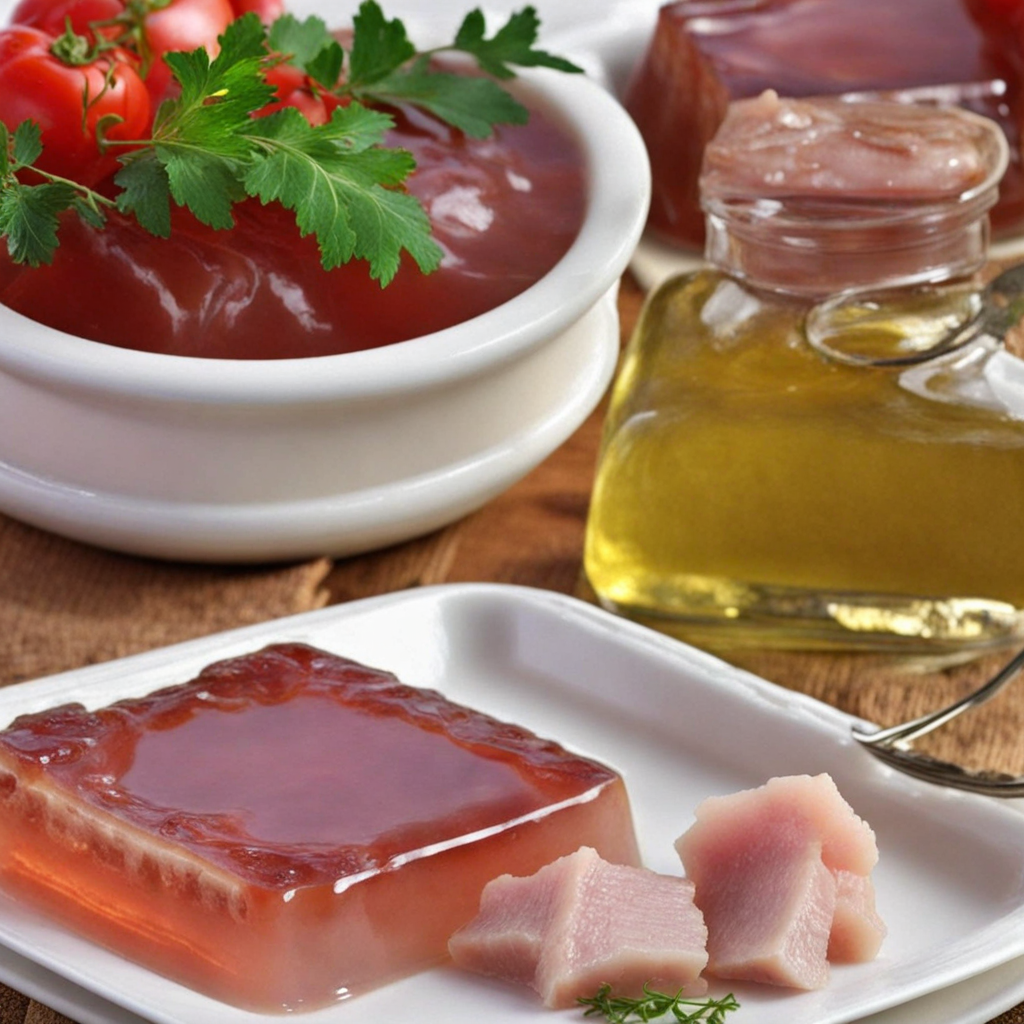Meat Jelly
Meat jelly, known in Romania as "răcitură," is a traditional dish that reflects the country's rich culinary heritage. This savory delicacy is made by slow-cooking various cuts of meat, often including pork, beef, or chicken, along with bones to extract the natural gelatin. The meat is simmered for several hours until tender, allowing the flavors to meld beautifully. Once cooked, the mixture is strained, and the resulting broth is poured over the meat, which is typically deboned and diced. The dish is then chilled until it sets into a firm, jelly-like consistency, creating a unique texture that is both intriguing and satisfying. The flavor profile of meat jelly is a delightful combination of savory, earthy, and slightly tangy notes. The slow cooking process enhances the natural taste of the meat while infusing it with aromatic herbs and spices, such as bay leaves, garlic, and peppercorns. When served, it is often presented in slices, showcasing the colorful bits of meat suspended within the translucent jelly. This dish is commonly accompanied by mustard or vinegar, which adds a zesty contrast that elevates the overall experience. The juxtaposition of the tender meat and the cool, firm jelly creates a playful mouthfeel that is both refreshing and hearty. Meat jelly is often enjoyed as an appetizer or a festive treat during special occasions and holidays in Romania. Its rustic charm and unique presentation make it a conversation starter at gatherings, inviting both curiosity and delight. Whether served on a charcuterie board alongside pickles and crusty bread or enjoyed as a standalone dish, meat jelly is a testament to the art of preserving and savoring traditional flavors, allowing adventurous eaters to discover a taste that is distinctly Romanian.
How It Became This Dish
The History of Piftie: A Romanian Culinary Gem Piftie, a traditional Romanian dish, is a culinary embodiment of the country's rich history and cultural tapestry. Often associated with the winter holidays and special occasions, this jellied meat dish has roots that extend deep into the country’s rural traditions and communal practices. The journey of piftie from its origins to a beloved culinary staple reflects the evolution of Romanian gastronomy, influenced by geography, cultural exchanges, and the agrarian lifestyle of its people. #### Origins and Ingredients Piftie, also known as "piftie de porc" (pork piftie), is primarily made from pork, particularly from parts that are rich in collagen, such as trotters and head. The dish is prepared by boiling these parts for several hours, allowing the natural gelatin to release, which forms the jelly-like consistency when cooled. Various spices, garlic, and sometimes vegetables are added to enhance its flavor. The origins of piftie can be traced back to the rural communities of Romania, where resourcefulness was paramount in the kitchen. In pre-industrial society, families often utilized every part of the animal to minimize waste. This practice led to the creation of piftie, a dish that not only showcased the culinary skills of Romanian cooks but also reflected the ethos of sustainability long before it became a contemporary concern. #### Cultural Significance Piftie is more than just a dish; it is a symbol of hospitality and celebration in Romanian culture. Traditionally served during the winter holidays, especially around Christmas and New Year’s, it is a staple at festive gatherings and family reunions. The dish is often prepared in large quantities and shared among friends and family, embodying the spirit of togetherness that characterizes Romanian festivities. Moreover, piftie has regional variations that showcase local customs and influences. In Transylvania, for instance, it might be seasoned with different spices or served alongside specific condiments, reflecting the diverse ethnic backgrounds found in this area, such as Hungarian and Saxon influences. In Moldova, the dish may be enriched with local herbs and served with pickles, showcasing the adaptability of piftie across different regions. #### A Culinary Tradition The preparation of piftie is steeped in tradition, often passed down through generations. In many households, making piftie is a communal activity that brings family members together. The process itself can be lengthy and labor-intensive, involving the careful selection of meat, the slow boiling to extract gelatin, and the meticulous cooling process to achieve the perfect texture. This communal aspect not only reinforces family bonds but also preserves the culinary knowledge and techniques that define Romanian cuisine. In rural areas, the making of piftie is often accompanied by storytelling and reminiscing, as older generations share tales of the past. This oral tradition plays a crucial role in maintaining cultural identity and continuity, making the act of preparing piftie a significant ritual that extends beyond mere sustenance. #### Historical Evolution The history of piftie is intertwined with the broader narrative of Romanian culinary traditions. As the country navigated through various historical epochs—feudalism, the Ottoman influence, and later, Austro-Hungarian rule—its food culture evolved. The incorporation of spices and cooking techniques from these periods enriched the flavor profile of piftie. In the 19th century, as Romania began to modernize and urbanize, piftie also adapted to changing lifestyles. While once exclusively a rural dish, it found its place in urban settings, particularly among the middle class who sought to maintain traditional practices in the face of rapid modernization. Piftie was often featured in festive banquets and gatherings, reinforcing its status as a dish of importance and prestige. With the advent of the 20th century and the subsequent political changes, including communism, piftie became a staple of the Romanian festive table, symbolizing national identity and resilience. During this time, the dish was embraced as a patriotic food, representing the culinary heritage of Romania amidst a backdrop of political upheaval. #### Contemporary Significance In the 21st century, piftie continues to enjoy popularity in Romania and among the Romanian diaspora worldwide. Its presence at festive occasions is a testament to its enduring appeal. Modern chefs and home cooks alike experiment with piftie, introducing variations that cater to contemporary palates, such as incorporating different meats or using vegetarian alternatives to appeal to a broader audience. Additionally, the rise of social media and food blogs has allowed piftie to gain recognition beyond Romania's borders. Food enthusiasts and culinary explorers are drawn to the dish's unique preparation and cultural significance, leading to a resurgence of interest in traditional Romanian cuisine. Festivals celebrating Romanian food often feature piftie as a highlight, showcasing its importance in the national culinary narrative. #### Conclusion Piftie is more than just a dish; it is a narrative woven through the fabric of Romanian culture and history. From its humble beginnings as a resourceful rural meal to its status as a cherished festive staple, piftie encapsulates the resilience and adaptability of Romanian culinary traditions. Its preparation, steeped in communal practices, and its role in celebrations reflect the values of family, hospitality, and cultural pride that resonate deeply within Romanian society. As Romania continues to engage with its culinary heritage while embracing modernity, piftie stands as a delicious reminder of the past—a dish that not only nourishes the body but also feeds the soul, bridging generations and celebrating the rich tapestry of Romanian identity. Whether enjoyed during the holidays or at family gatherings, piftie remains a testament to the enduring power of food in connecting people to their roots and each other.
You may like
Discover local flavors from Romania


